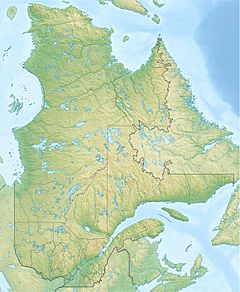Rivière à l'Ours (Minganie) facts for kids
Quick facts for kids Ours River |
|
|---|---|
| Other name(s) | Rivière à l'Ours |
| Country | Canada |
| Province | Quebec |
| Region | Côte-Nord |
| RCM | Minganie |
| Physical characteristics | |
| River mouth | Gulf of Saint Lawrence 0 metres (0 ft) 50°17′54″N 63°03′29″W / 50.298333°N 63.058056°W |
| Basin features | |
| Basin size | 260 square kilometres (100 sq mi) |
The Ours River (which means Bear River in French) is a river in Quebec, Canada. It flows into the Gulf of Saint Lawrence. The river is located in the Minganie Regional County Municipality, near the town of Havre-Saint-Pierre.
Most of the river valley is only accessible by snowmobile routes in winter. The lower part of the river can be reached by Quebec Route 138. The river's surface usually freezes from early November to late April. However, it's safest to travel on the ice from late November to early April.
Contents
Where the River Flows
The Ours River has two main parts, or branches. These branches meet about 6.4 kilometers (4 miles) before the river reaches the Gulf of Saint Lawrence. Both branches have many fast-flowing sections called rapids, and small waterfalls. Because of these, it's not possible to travel along the river by canoe.
River's Beginning: Lac à l'Ours
The Ours River starts at a lake called Lac à l'Ours, which means Bear Lake. This lake is 7.5 kilometers (4.7 miles) long and sits at an elevation of 60 meters (197 feet) above sea level. Lac à l'Ours is surrounded by smaller lakes and is located in the area of Havre-Saint-Pierre.
Journey to the Sea
From Lac à l'Ours, the river flows for about 13.4 kilometers (8.3 miles). During this journey, it drops 60 meters (197 feet) in elevation. The river mostly flows through forested areas. It collects water from other small lakes along the way.
The river eventually flows into a bay called Victor Bay, which is part of a larger area called Grande Hermine Bay. This bay is located across from Anticosti Island. The mouth of the river is also part of the Mingan Archipelago National Park Reserve.
The River's Drainage Area
The area that the Ours River drains, known as its basin, covers about 260 square kilometers (100 square miles). This basin includes several lakes, such as Lac à l'Ours, Lac Kakuahkuepaniuhiht, and Lac Malville.
The Ours River basin is located between two other river basins: the Romaine River to the west and the Corneille River to the east. Parts of the basin are in the unorganized territory of Lac-Jérôme and parts are in the municipality of Havre-Saint-Pierre.
You can reach the area around Lac à l'Ours by canoe from nearby rivers like the Romaine and Puyjalon rivers. However, the easiest way to get there is by float plane. Explorers like Henry de Puyjalon, Joseph Obalski, and James Richardson studied this region in the late 1800s.
Land Around the River
The land near the coast where the Ours River flows is flat and often marshy. It has a layer of marine deposits, which are materials left behind by the sea.
Further inland, the region becomes a plateau. This means it's a high, flat area where the bedrock (the solid rock beneath the soil) is often visible. The surface of this plateau is quite uneven, with many deep, V-shaped valleys. These valleys were shaped by natural forces like faults in the rock and by glaciers moving across the land. The hills in this area are generally around 122 meters (400 feet) high, while the river bottoms are about 61 meters (200 feet) lower.
Nature and Wildlife
The Ours River area is part of specific ecological regions of Quebec. In 1966, much of the region had very few trees. This was because a large forest fire about 20 years earlier had destroyed almost all the plants and burned away the thin layer of soil that covered the rock.
However, some trees remained along the rivers. These included balsam fir, spruce, birch, and aspen. The area is home to many beavers, which were trapped by the local Indigenous people from the Mingan Reserve. Other common animals found here include otters, minks, hares, partridges, ducks, bears, and foxes. There are not many caribou or moose in this region. The lakes in the area are home to landlocked salmon and brook trout.
Name History
The name "Rivière à l'Ours" (Ours River) was first seen on a map from 1960. It officially became the river's name on December 5, 1968.
Sources


